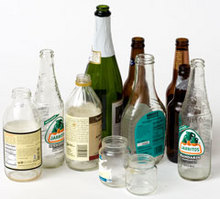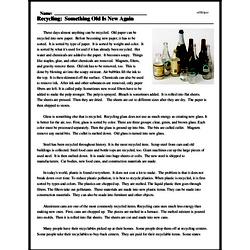Recycling: Something Old Is New Again
These days almost anything can be recycled. Old paper can be recycled into new paper. Before becoming new paper, it has to be sorted. It is sorted by type of paper. It is sorted by weight and color. It is sorted by what it's used for and if it has already been recycled. Hot water and chemicals are added to the paper. It becomes soupy. Things like staples, glue, and other chemicals are removed. Magnets, filters, and gravity remove them. Old ink has to be removed, too. This is done by blowing air into the soupy mixture. Air bubbles lift the ink to the top. It is then skimmed off the surface. Chemicals can also be used to remove ink. After ink and other substances are removed, only paper fibers are left. It is called pulp. Sometimes new wood fibers have to be added to make the pulp stronger. The pulp is sprayed. Bleach is sometimes added. It is rolled into flat sheets. The sheets are pressed. Then they are dried. The sheets are cut to different sizes after they are dry. The paper is then shipped to stores.
Glass is something else that is recycled. Recycling glass does not use as much energy as creating new glass. It is better for the air, too. First, glass is sorted by color. There are three groups: clear, green, and brown glass. Each color must be processed separately. Then the glass is ground up into bits. The bits are called cullet. Magnets remove any metal bits. The cullet is melted down. Old glass is turned into new glass.
Steel has been recycled throughout history. It is the most recycled item. Scrap steel from cars and old buildings is collected. Steel food cans and bottle tops are recycled, too. Giant machines cut up the large pieces of used steel. It is then melted down. It is made into huge sheets or coils. The new steel is shipped to manufacturers. Car bodies, new food cans, and construction materials are made.




